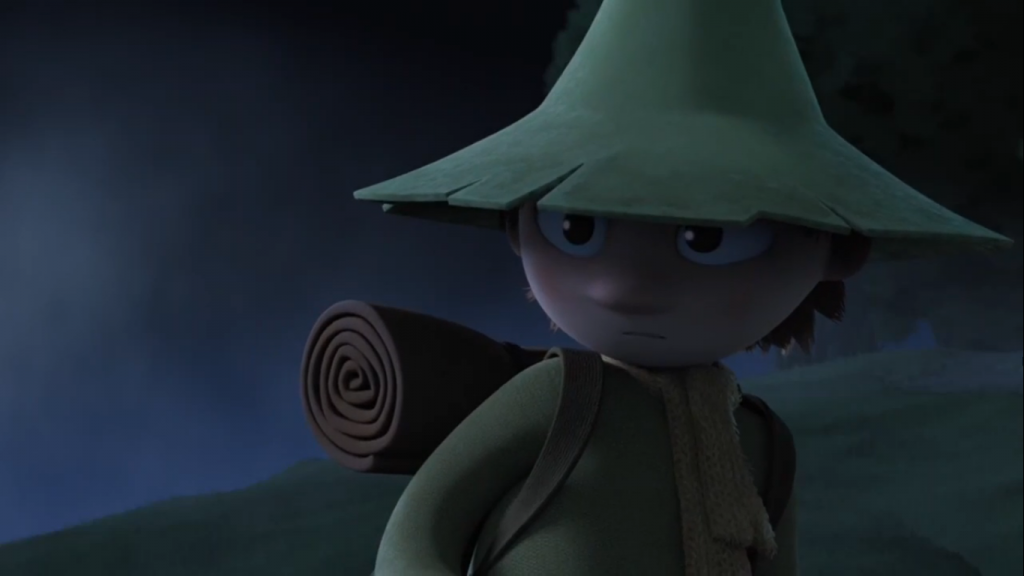
In the first part of this series, I examined and discussed how the character of Hitori Bocchi was a validating experience for me because it portrayed social anxiety in an empathetic and humanizing manner. With this in mind, it is important to realize that Bocchi’s experiences are just one of the many ways in which people experience and manifest their social anxiety. This second article will examine a character from a different animated series, and discuss how their portrayal showcases a different side to social anxiety, specifically how social anxiety can be connected with social exhaustion.
Snufkin is one of the main characters of Tove Jansson’s Moomins franchise, an iconic character who many people love across the globe (especially Europe and Japan). He is a vagabond known for travelling the world, carrying very few personal possessions, enjoying his solitude within nature, and valuing his personal freedom. As is the case of many fictional characters, these key traits have commonly been exaggerated to the point of creating a very specific image of Snufkin’s character. In many adaptations Snufkin is depicted as an incredibly wise individual, who discovers solutions to the problems he and his friends encounter, and seldom, if ever, experiences anger or personal psychological conflicts.
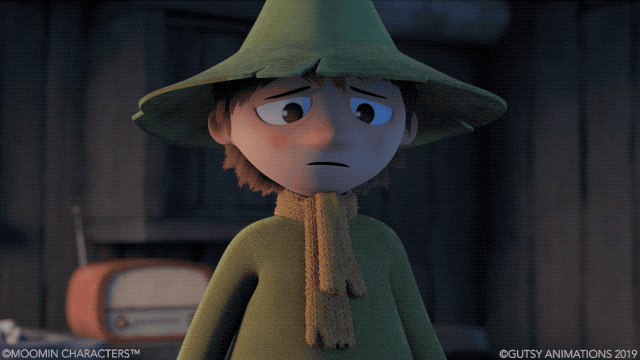
“The Spring Tune” serves a special purpose in the series, as it is the viewer’s introduction to Snufkin’s character, and his relationship with other characters in the series, specifically Moomintroll. Additionally, it is the first episode of the series that hints at Snufkin’s social anxiety. Throughout the episode, Snufkin wishes to discover his “Spring Tune”, a new song he composes for his harmonica, every first day of spring to celebrate the return of the season and to announce his return to Moominvally. Unfortunately for Snufkin, he cannot find his usual inspiration to compose the song and makes the decision to delay his arrival, because he feels his best friend Moomintroll would distract him from his composing.
“It’s not ready yet. And neither am I. To come back yet, I mean… I can’t think of [Moomintroll] now. I’m sorry Moomintroll. Tonight I have to be alone with my tune.”
After making this decision Snufkin is very much at peace, enjoying his time alone, and developing his tune naturally. However, as the episode progresses the weight of his choice begins to erode at him, especially when the character of Teety-Woo enters the picture.

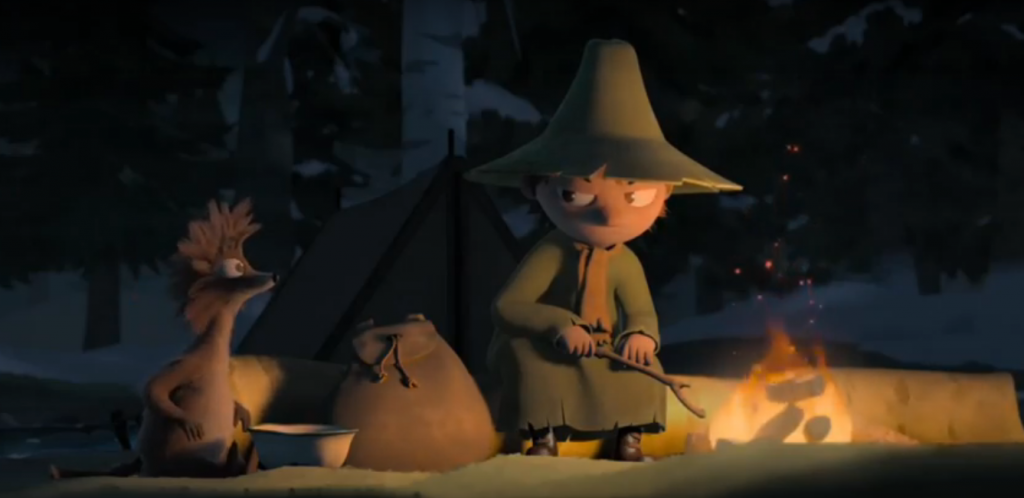
This encounter struck very close to home for me, as a person who not only experiences social anxiety, but who is also on the autistic spectrum. Needing a space for yourself to “recharge” is something that is extremely important for those of us on the spectrum, as sensory inputs are more exhausting to us, especially in comparison to the average neurotypical person. And once you have begun the process of “recharging” small irritants, which normally would not be such a great bother, become larger annoyances. I can recall my own instances of snapping at people I care about while in the midst of this state of being, and feeling upset with myself afterwards because of how I behaved.
By showcasing Snufkin’s emotional process throughout this interaction, Moominvalley demonstrates to viewers why people who find social interactions draining, may “unexpectedly” snap at others. Instead of portraying Snufkin as the only the person at “fault” with this interaction, the show instead showcases how both he and Teety-Woo failed to properly communicate with each other, which lead to Snufkin’s outburst. The message at the end of the episode stresses the importance of giving people a space to themselves, and respecting that space. It is very rare to find a series willing to showcase this type of message, especially in a manner that is sympathetic towards the person recharging. This makes me hopeful that portraying relaxing by oneself as an essential, healing act which can benefit a person’s mental health, can combat the perception that seeking solitude is a negative or “anti-social” action.
Aside from Snufkin’s interpersonal struggle with Teety-Woo in episode two, the series also showcases Snufkin’s personal struggle of wanting to be solitary and yet also wanting to connect with others. As mentioned in the introduction, Snufkin is a highly independent character, who greatly values his personal freedom and ability to travel. One of the changes the Moominvalley series has done to Snufkin’s character is to re-frame this aspect of from merely being a just matter of individual values. Instead his desire for independence is actually an important facet of his psyche, and a source of deep personal conflict. This is showcased through visual metaphor in the second episode, where Snufkin finds tree branches clinging to him in a manner very similar to hands grasping at him. His discomfort is at the idea of being controlled, or forced to stay confined in one place, or to a person.
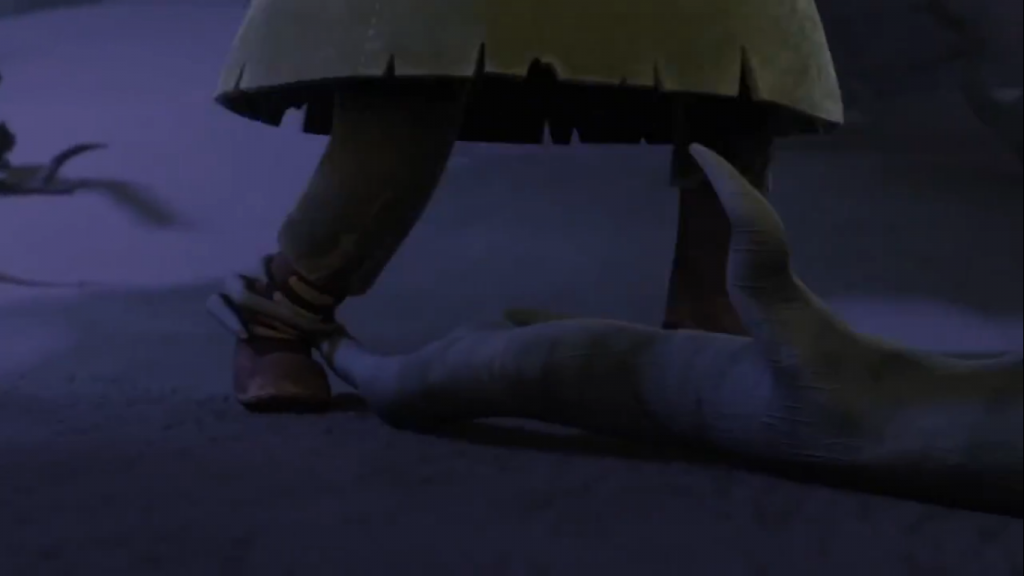
Episode seven, “Snufkin and the Park Keeper”, adds another layer to Snufkin’s personal conflict. During this episode Snufkin has a flashback to party where he enjoyed spending time together with Moomintroll. At first the party goes well, with the pair laughing and having a good time sitting together on the sidelines of the party, but still clearly a part of it.

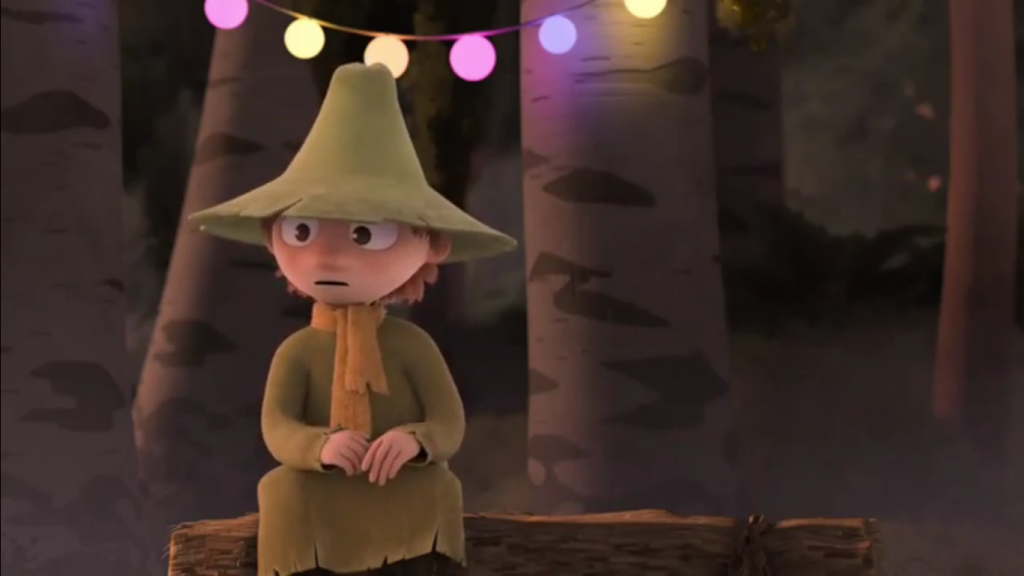
When Moomintroll returns to their sitting place he finds that Snufkin has left, leaving Moomintroll alone and feeling rejected by his best friend.

“I had to get away for a while. I was starting to feel enclosed. It’s not that I don’t like people. I just feel caged in sometimes. Every now and again, just for a while, I need my space.”
While some would be quick to feel angry at Snufkin for his actions during the party, I instead found myself feeling empathetic towards him, as I have had similar experiences in my own life. Parties, and large social gatherings, can be extremely exhausting, especially when you experience social anxiety or are on the autistic spectrum. And Snufkin’s comments about feeling “caged in” sums up how some of these social events have felt to me. With too many sensory inputs going on at once, caused by too many people saying and doing different things, and no socially acceptable way to excuse oneself to find a quiet space, these events can feel like being entrapped someplace unpleasant like a jail.
Fortunately, it is possible to create strategies to find these events more enjoyable, or at least manageable, so we do not experience burnout from social events. Snufkin, coincidentally, incorporates one of my preferred tactics in this episode, by spending his time at the party with a friend. Having the ability to chat, or even just sit nearby, one of my close friends is something that I find calming in these hectic social environments. Unfortunately, even with a good strategy in place, I can still find it difficult to enjoy the party or social gathering, and find it is necessary to leave in order to take care of myself. When I was younger doing this either felt like a defeat, or I was being disrespectful, and unintentionally hurting my family or friends by leaving early. Sometimes bullies would even make me feel worse, by making me feel bad for expressing my wish to leave a party early, or to find a quiet space to calm myself. So Snufkin’s anxiety over wanting to apologize to Moomintroll for leaving unexpectedly, is very real and comprehensible to me.
Snufkin’s experiences in this episode also showcases the struggle people with social anxiety face on a regular occasion, where we have to fight our irrational thoughts so we can see that our friends still love us, even when we need to leave to take care of ourselves. As Steve Box, the Series Director and Co-Head Writer, notes in the “Creators Comments” for this episode “[Snufkin’s] in jail, but it’s of his own making. So he has to take responsibility to break out of that.” Thankfully Snufkin has Moomintroll, who knows and understands that Snufkin needs his space and ultimately does not think less of his friend for tending to his needs. I also have friends and family who know and understand what I need to do in social situations to take care of myself, which helps me feel reassured.
Having social anxiety is not easy; sometimes you get so overwhelmed that you accidentally snap at people, or you have to leave the situation to take care of yourself. However, as this series has shown, even when things get tough people who experience social anxiety are still worthy of respect, care, and friendship. Snufkin’s character arc is still ongoing, but hopefully the Moominvalley team will continue to showcase his social anxiety in this empathetic light.

Thank you for this post! It’s very interesting and gave me a new perspective on Snufkin’s struggles. I have a sister who is on the spectrum and also has anxiety, and this helped me to understand and relate to her better! Sometimes I feel a bit like Moomintroll in this kind of situations, because I tend to be more sociable and maybe sometimes expect too much from my ‘Snufkin’ sister…
I’ll probably recommend her the show, I think she’ll enjoy a relatable character like Snufkin and the way the show deals with themes like social anxiety 🙂